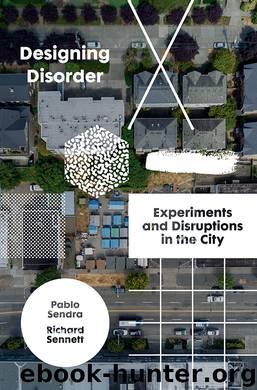Designing Disorder by Richard Sennett

Author:Richard Sennett
Language: eng
Format: epub
Publisher: Verso Books
Opening Up Closed Developments
For reversing the isolating effects of areas of the city that were designed with too much order, it is important to consider their connections with surrounding areas. In the case of isolated suburban gated communities, it can be difficult to find pieces of urban fabric to connect with the neighbourhood. However, there are other cases of enclosed and monofunctional urban areas, particularly those within the inner city, that have strong potential to be opened up.
In the case of inner-city housing estates, approaches to regeneration so far have involved subdividing and closing the space, densifying through adding more buildings, or demolishing and redeveloping the estate. These approaches do not create possibilities for new relationships nor open up closed developments. For doing so, we must intervene on the margins,13 on the places where various isolated places meet, where there is potential for interaction between these urban areas and the people who live there. Richard, in an analogy with natural ecosystems, explains this process of intervening on the margins as turning closed ‘boundaries’, which are limits with no interaction between the two sides, into permeable ‘borders’, which are full of exchange.14
The initial step is to identify streets and urban spaces with the potential to become permeable borders or places for connection, association and exchange. For doing so, it is necessary to look at how the place works as well as people’s habits, patterns of movement, interaction and socialisation. It is first necessary to detect where the main pedestrian fluxes are, the main points of destination, where people stop and spend time, and how often and when ‘outsiders’ enter the area.
Second, it is necessary to recognise the current main spaces for social exchange – where people from different places interact, how these places relate to their surroundings, and the kinds of activities that take place in these spaces. These could be a community centre, a semi-private garden, an open public space, a light shelter or any other particular place in the neighbourhood. Third, it is important to detect the current barriers that isolate places from one another, such as walls, fences, control points, physical barriers that block the entrance to an area and other dissuasive measures to prevent strangers from entering a place. In places like housing estates, these measures for preventing the presence of strangers can vary from a gated area where only neighbours have a key to other physical barriers that do not impede but dissuade access, such as steps or leafy bushes protecting a space.
This analysis can identify the different obstacles that have broken the continuity of the street and identify potential places for intervention to revert the area’s isolation and fragmentation. Jane Jacobs proposed that social housing neighbourhoods and other monofunctional developments should be ‘rewoven back into the urban fabric’, which implied ‘strengthening the surrounding fabric’.15 She also proposed connecting these neighbourhoods to adjacent urban areas and rethinking the streetscapes that generate these connections. Building on Jacobs’s proposal, through more clearly defining the connections between these areas
Download
This site does not store any files on its server. We only index and link to content provided by other sites. Please contact the content providers to delete copyright contents if any and email us, we'll remove relevant links or contents immediately.
The Secret History by Donna Tartt(16611)
The Social Justice Warrior Handbook by Lisa De Pasquale(11486)
Thirteen Reasons Why by Jay Asher(7783)
This Is How You Lose Her by Junot Diaz(5754)
Weapons of Math Destruction by Cathy O'Neil(5032)
Zero to One by Peter Thiel(4818)
The Myth of the Strong Leader by Archie Brown(4786)
Promise Me, Dad by Joe Biden(4441)
Stone's Rules by Roger Stone(4413)
Beartown by Fredrik Backman(4405)
How Democracies Die by Steven Levitsky & Daniel Ziblatt(4393)
The Fire Next Time by James Baldwin(4338)
100 Deadly Skills by Clint Emerson(4072)
A Higher Loyalty: Truth, Lies, and Leadership by James Comey(4027)
Rise and Kill First by Ronen Bergman(4009)
The David Icke Guide to the Global Conspiracy (and how to end it) by David Icke(3876)
The Farm by Tom Rob Smith(3870)
Secrecy World by Jake Bernstein(3774)
The Doomsday Machine by Daniel Ellsberg(3726)
